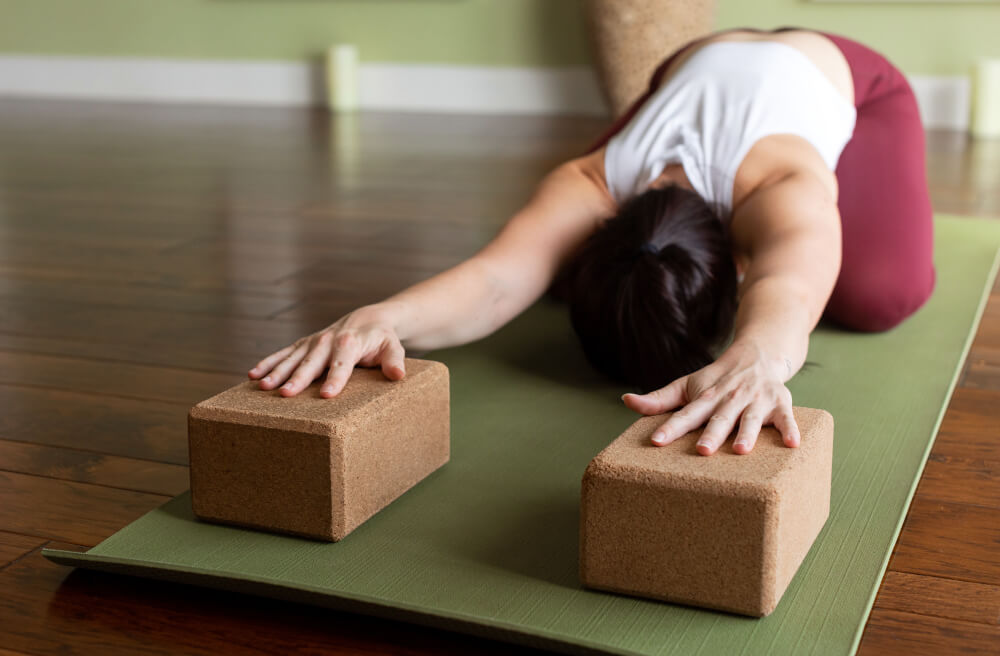
Yoga Asana 101: Basic Poses You Should Know
May 15, 2020
It’s a universal experience for beginner yogis: once you learn proper alignment for foundational poses, the physical practice starts to become more accessible. Most vinyasa classes will feature a few of the same basic postures, or asanas, that all practitioners should be familiar with:

Child’s Pose (Balasana)
One of the first poses many of us are introduced to in yoga, the child’s pose helps the practitioner stretch the lower back and inner thighs. It is often suggested as a resting posture to take independently if you become fatigued or lose the steady rhythm of your breathing while you practice. To come into child’s pose:
- From all fours, sit your hips back toward your heels.
- Divide your knees to your comfort level to access an inner thigh stretch.
- Stretch your arms out in front of you and allow your forehead to rest on your mat.
Downward-Facing Dog (Adho Mukha Svanasana)
Many of us saw or heard this pose before we even stepped on a yoga mat. This inverted V-shape has an impact on the whole body, creating a stretch for your hamstrings, calves, and the arches of your feet while helping build strength in the shoulders, arms, and abdomen. Downward-facing dog is considered an inversion because your head is below the level of your heart.
- From all fours, tuck your toes and slowly allow your tailbone to lift into a V-shape.
- If your hamstrings are tight, you may keep your knees softly bent to relieve tension.
- Actively press your chest back toward your thighs while allowing your heels to sink toward your mat.
- Relax your head and neck and gaze either between your shins or toward your navel.
- With every exhale breath, practice drawing your navel in toward your spine and engaging the low abdomen.
Mountain Pose (Tadasana)
Considered a blueprint posture for nearly your entire yoga practice, mountain pose is so much more than just standing still. When practicing mountain, your feet actively plug down into your mat, your quadriceps engage, your pelvic floor draws up and in as your tailbone lengthens down, and your shoulder blades pull down your back. Sometimes practiced with arms lifted toward the sky (urdvha hastasana, or upward salute, variation), mountain serves as a starting point for practicing engagement of the full body as well as the bandhas, or energetic locks.
Standing Forward Fold (Uttanasana)
A basic element of a sun salutation, the standing forward fold creates a stretch for the entire backline of your body. Don’t be discouraged if you “can’t touch your toes” in a standing forward fold.
- From a mountain pose, exhale and hinge from your hips to begin your forward fold, with your hands either at heart center or arms in a reverse swan dive.
- If your hamstrings are tight, bending your knees is appropriate as you create more space in the backs of your thighs over time.
- Keep your weight shifted forward in your feet, and relax your head and neck completely.
Yoga is called a “practice” for a reason: there’s no mastery, and there’s no goal you’re trying to achieve as you learn how each Asana works in your body. The first downward-facing dog you take will look very different from the 50th and even 500th as you develop body awareness and learn to make adjustments to each pose.
The key to embodying basic postures and becoming familiar enough with the yoga Asana to flow smoothly during a class is to practice. We have over 100 videos available in our online library for you to choose from to practice at home, with new live-streamed yoga classes and recordings offered every day. Our skilled instructors provide guidance and cues to help you modify or advance any pose, from the most fundamental to the most complicated. Join us at home – we’d love to “see” you on your mat!





